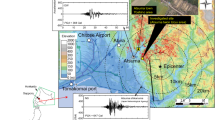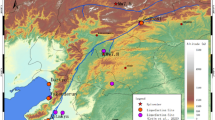Abstract
A novel and robust slope stability evaluation method based on energy method and radial slices method (RSM) is proposed and validated in terms of strength parameter sensitivity and determination of the critical sliding surface. The sensitivity analysis shows that the deviation from the limit equilibrium method (LEM) does not exceed 1.5%, demonstrating the feasibility of the proposed method. Different from LEM, the proposed framework gets functional enhancements: (1) This method considers the failure mode of the slope as a combination of translation and rotation, which is more in line with the actual monitoring results; (2) if the virtual displacement is regarded as a variable, the effect of accumulated displacement on slope stability can be studied; (3) if the factor of safety (FOS) for the slope is less than 1, this method can be extended to analyze movement of landslide mass after instability using the energy balance. Then, the proposed framework is applied to the 1963 Vajont event and Xinhua event to analyze the slope stability at the changes of reservoir water level and the dynamics after instability. Comparing slopes with different deformation patterns in calculating stability, the paper finds that permeability is the key to understanding the deformation response and summarizes the failure mechanism. For 1963 Vajont landslide, the proposed framework calculates the maximum velocity of the intermediate section to be 21.51 m/s, which is in general agreement with the inference by Hendron and Patton (Eng Geol 24:475–491, 1987), and superior to Zaniboni and Tinti (Nat Hazards 70:567–592, 2014)’s calculation of less than 20 m/s. Through research and application, the superiority of the proposed framework in analyzing slope hazards is shown.





















Similar content being viewed by others
References
Alonso EE, Pinyol NM (2010) Criteria for rapid sliding. I A review of Vaiont case. Eng Geol 114(3–4):198–210
Bandara S, Ferrari A, Laloui L (2016) Modelling landslides in unsaturated slopes subjected to rainfall infiltration using material point method. Int J Numer Anal Met 40(9):1358–1380
Bear J (1972) Dynamics of Fluids in Porous Media. American Elsevier Pub. Co
Carlà T, Intrieri E, Raspini F, Bardi F, Farina P, Ferretti A, Colombo D, Novali F, Casagli N (2019) Perspectives on the prediction of catastrophic slope failures from satellite InSAR. Sci Rep 9(1):14137
Chen ML, Lv PF, Zhang SL, Chen XZ, Zhou JW (2018) Time evolution and spatial accumulation of progressive failure for Xinhua slope in the Dagangshan reservoir, Southwest China. Landslides 15:565–580
Ciabatti M (1964) La dinamica della frana del Vajont. Museo geologico Giovanni Capellini XXXII:139–153 (in Italian)
Fan X, Xu Q, Liu J, Subramanian SS, He C, Zhu X, Zhou L (2019) Successful early warning and emergency response of a disastrous rockslide in Guizhou province, China. Landslides 16:2445–2457
Fredlund MD (2009) SVSlope User’s manual. SoilVision System Ltd., Saskatoon, Canada
Fredlund DG, Krahn J (1977) Comparison of slope stability methods of analysis. Can Geotech J 14(3):429–439
Fredlund DG, Krahn J, Pufahl DE (1981) The relationship between limit equilibrium slope stability methods. Proc Int Conf Soil Mech Found Eng 3:409–416
GeoSlope International Ltd. Seep/W user’s guide for finite element seepage analysis. Calgary, Alta: GEO-SLOPE International Ltd, 2007
Ghirotti M (1994) Modellazione numerica della frana del Vajont sulla base di nuovi dati. Geol Romana 30:207–216 (in Italian)
Girardi V, Ceccato F, Rohe A, Simonini P, Gabrieli F (2022) Failure of levees induced by toe uplift: Investigation of post-failure behavior using material point method. J Rock Mech Geotech
Guzzetti F, Peruccacci S, Rossi M, Stark CP (2007) Rainfall thresholds for the initiation of landslides in central and southern Europe. Meteorol Atmos Phys 98:239–267
Guzzetti F, Peruccacci S, Rossi M, Stark CP (2008) The rainfall intensity–duration control of shallow landslides and debris flows: an update. Landslides 5:3–17
Hendron AJ, Patton FD (1985) The Vaiont slide, a geotechnical analysis based on new geologic observations of the failure surface. Technical Report GL-85–5.Department of the Army, U.S. Army Corps of Engineers, Washington, DC
Hendron AJ, Patton FD (1987) The Vaiont slide - A geotechnical analysis based on new geologic observations of the failure surface. Eng Geol 24:475–491
Intrieri E, Raspini F, Fumagalli A, Lu P, Conte SD, Farina P, Allievi J, Ferretti A, Casagli N (2018) The Maoxian landslide as seen from space: detecting precursors of failure with Sentinel-1 data. Landslides 15:123–133
Jiang H, Xie Y (2011) A note on the Mohr-Coulomb and Drucker-Prager strength criteria. Mech Res Commun 38(4):309–314
Kou RM (1988) Radially cutting method-A new method to analyse the stability of soil slopes. Hydrogeol Eng Geol 03:47–50 (in Chinese)
Lade PV, De Boer R (1997) The concept of effective stress for soil, concrete and rock. Geotechnique 47(1):61–78
Li HB, Qi SC, Yang XG, Li XW, Zhou JW (2020) Geological survey and unstable rock block movement monitoring of a post-earthquake high rock slope using terrestrial laser scanning. Rock Mech Rock Eng 53(10):4523–4537
Lin S, Zheng H, Han B, Li Y, Han C, Li W (2022) Comparative performance of eight ensemble learning approaches for the development of models of slope stability prediction. Acta Geotech 17(4):1477–1502
Liu SY, Shao LT, Li HJ (2015) Slope stability analysis using the limit equilibrium method and two finite element methods. Comput Geotech 63:291–298
Lu N, Godt J (2008) Infinite slope stability under steady unsaturated seepage conditions. Water Resour Res 44(11)
Lu N, Likos WJ (2006) Suction stress characteristic curve for unsaturated soil. J Rock Mech Geotech 132(2):131–142
Ma G, Bui HH, Lian Y, Tran KM, Nguyen GD (2022) A five-phase approach, SPH framework and applications for predictions of seepage-induced internal erosion and failure in unsaturated/saturated porous media. Comput Method Appl M 401:115614
Müller L (1964) The rock slide in the Vajont valley. Rock Mech Eng Geol 2:148–212
Müller L (1968) New considerations on the Vaiont slide. Rock Mech Eng Geol 6:1–91
Ozbay A, Cabalar AF (2015) FEM and LEM stability analyses of the fatal landslides at Çöllolar open-cast lignite mine in Elbistan, Turkey. Landslides 12:155–163
Paronuzzi P, Rigo E, Bolla A (2013) Influence of filling–drawdown cycles of the Vajont reservoir on Mt. Toc Slope Stab Geomorphol 191:75–93
Paronuzzi P, Bolla A, Rigo E (2016) Brittle and ductile behavior in deep-seated landslides: learning from the Vajont experience. Rock Mech and Rock Eng 49(6):2389–2411
Qi S, Vanapalli SK (2015) Hydro-mechanical coupling effect on surficial layer stability of unsaturated expansive soil slopes. Comput Geotech 70:68–82
Qi S, Vanapalli SK (2016) Influence of swelling behavior on the stability of an infinite unsaturated expansive soil slope. Comput Geotech 76:154–169
Segui C, Rattez H, Veveakis M (2020) On the stability of deep–seated landslides. The cases of Vaiont (Italy) and Shuping (Three Gorges Dam, China). J G Res-Earth 125(7):e2019JF005203
Selli R, Trevisan L (1964) Caratteri e interpretazione della Frana del Vaiont. Giorn Geol 32:7–104
Tang M, Xu Q, Yang H, Li S, Iqbal J, Fu X, Huang X, Cheng W (2019) Activity law and hydraulics mechanism of landslides with different sliding surface and permeability in the three gorges reservoir area. China Eng Geol 260:105212
Tika TE, Hutchinson JN (1999) Ring shear tests on soil from the Vaiont landslide slip surface. Géotechnique 49(1):59–74
Wang B, Vardon PJ, Hicks MA (2018) Rainfall-induced slope collapse with coupled material point method. Eng Geol 239:1–12
Wang G, Zhao B, Wu B, Zhang C, Liu W (2023) Intelligent prediction of slope stability based on visual exploratory data analysis of 77 in situ cases. Int J Min Sci Techno 33(1):47–59
Xu Q, Peng D, Zhang S, Zhu X, He C, Qi X, Zhao K, Xiu D, Ju N (2020) Successful implementations of a real-time and intelligent early warning system for loess landslides on the Heifangtai terrace. China Eng Geol 278:105817
Yamin M, Liang RY (2010) Limiting equilibrium method for slope/drilled shaft system. Int J Numer Anal Met 34(10):1063–1075
Yi QL, Zhao NH, Liu YL (2017) Model of landslide stability calculation based on energy conservation. Rock and Soil Mechanics 38:1–10 (in Chinese)
Zaniboni F, Tinti S (2014) Numerical simulations of the 1963 Vajont landslide, Italy: application of 1D Lagrangian modelling. Nat Hazards 70(1):567–592
Zhang L, Shi B, Zhang D, Sun Y, Inyang HI (2020) Kinematics, triggers and mechanism of Majiagou landslide based on FBG real-time monitoring. Environ Earth Sci 79(9):1–17
Zhou JW, Lu PY, Yang YC (2017) Reservoir landslides and its hazard effects for the hydropower station: a case study. Workshop on world landslide forum. Springer, Cham, pp 699–706
Funding
This work was supported by the National Natural Science Foundation of China (U2240221, 41977229) and the Fundamental Research Funds for the Central Universities (JZ2023HGQA0096). These supports are gratefully acknowledged.
Author information
Authors and Affiliations
Corresponding author
Ethics declarations
Conflict of interest
The authors declare that they have no known competing financial interests or personal relationships that could have appeared to influence the work reported in this paper.
Additional information
Publisher's Note
Springer Nature remains neutral with regard to jurisdictional claims in published maps and institutional affiliations.
Rights and permissions
Springer Nature or its licensor (e.g. a society or other partner) holds exclusive rights to this article under a publishing agreement with the author(s) or other rightsholder(s); author self-archiving of the accepted manuscript version of this article is solely governed by the terms of such publishing agreement and applicable law.
About this article
Cite this article
Chen, Ml., Zhou, Jw. & Yang, Xg. A novel approach for slope stability evaluation considering landslide dynamics and its application to reservoir landslide. Nat Hazards 120, 3589–3621 (2024). https://doi.org/10.1007/s11069-023-06343-w
Received:
Accepted:
Published:
Issue Date:
DOI: https://doi.org/10.1007/s11069-023-06343-w




